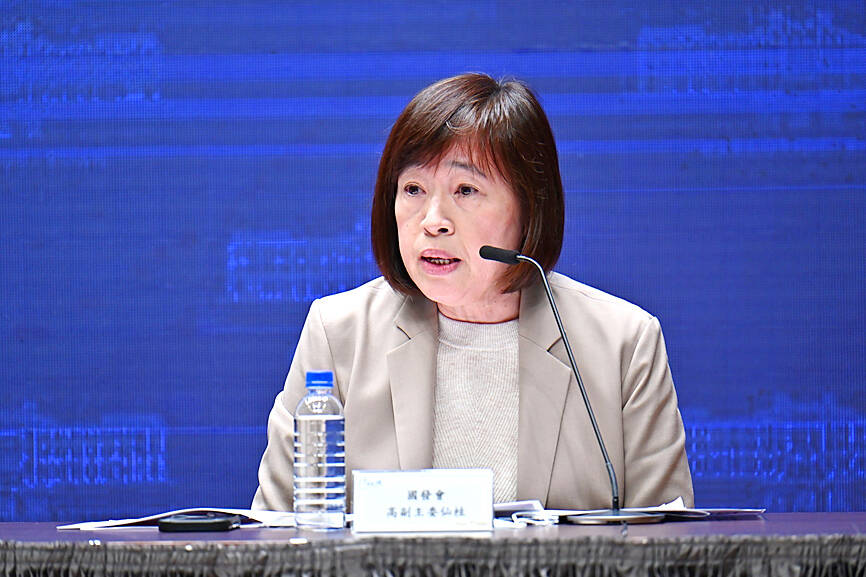Taiwan’s current business cycle, which peaked in January last year, is expected to bottom out in the second quarter, the National Development Council (NDC) said on Monday.
NDC Deputy Minister Kao Shien-quey (高仙桂) said that trends in the council’s composite index of leading indicators, the Chung-Hua Institution for Economic Research’s purchasing managers’ index and the Taiwan Institute of Economic Research’s composite index of manufacturing indicators showed signs that the domestic economy might hit bottom next quarter.
A traditional business cycle undergoes four stages: expansion, peak, contraction and trough, with expansion averaging 40 months and contraction lasting about 15 months in Taiwan, the council said, citing historical patterns.

Photo courtesy of the Executive Yuan
Taiwan is in its 15th business cycle, which included a 71-month expansion phase from March 2016 to January last year, when the economy benefited from a global supply chain shift to Taiwan, the return of Taiwanese businesses from overseas and robust demand for high-tech gadgets amid a booming stay-at-home economy, it said.
Its statistics showed that the expansion period was much longer than Taiwan’s historical average of 40 months.
It was the second-longest on record behind a 96-month period that began in September 1956.
However, after peaking in January last year, the cycle entered a period of decline, the council said.
With contractions in the business cycle averaging 15 months in the past, next month should be the trough, Kao said.
It remains to be seen whether the cycle would bottom out in the second quarter, as there are still many variables involved, such as the monetary policies of major central banks, the pace of economic recovery in China, geopolitical developments including the Russia-Ukraine war, and continued tension between the US and China, Kao said.
Additional reporting by Chen Cheng-hui

The US dollar was trading at NT$29.7 at 10am today on the Taipei Foreign Exchange, as the New Taiwan dollar gained NT$1.364 from the previous close last week. The NT dollar continued to rise today, after surging 3.07 percent on Friday. After opening at NT$30.91, the NT dollar gained more than NT$1 in just 15 minutes, briefly passing the NT$30 mark. Before the US Department of the Treasury's semi-annual currency report came out, expectations that the NT dollar would keep rising were already building. The NT dollar on Friday closed at NT$31.064, up by NT$0.953 — a 3.07 percent single-day gain. Today,

‘SHORT TERM’: The local currency would likely remain strong in the near term, driven by anticipated US trade pressure, capital inflows and expectations of a US Fed rate cut The US dollar is expected to fall below NT$30 in the near term, as traders anticipate increased pressure from Washington for Taiwan to allow the New Taiwan dollar to appreciate, Cathay United Bank (國泰世華銀行) chief economist Lin Chi-chao (林啟超) said. Following a sharp drop in the greenback against the NT dollar on Friday, Lin told the Central News Agency that the local currency is likely to remain strong in the short term, driven in part by market psychology surrounding anticipated US policy pressure. On Friday, the US dollar fell NT$0.953, or 3.07 percent, closing at NT$31.064 — its lowest level since Jan.

Hong Kong authorities ramped up sales of the local dollar as the greenback’s slide threatened the foreign-exchange peg. The Hong Kong Monetary Authority (HKMA) sold a record HK$60.5 billion (US$7.8 billion) of the city’s currency, according to an alert sent on its Bloomberg page yesterday in Asia, after it tested the upper end of its trading band. That added to the HK$56.1 billion of sales versus the greenback since Friday. The rapid intervention signals efforts from the city’s authorities to limit the local currency’s moves within its HK$7.75 to HK$7.85 per US dollar trading band. Heavy sales of the local dollar by

The Financial Supervisory Commission (FSC) yesterday met with some of the nation’s largest insurance companies as a skyrocketing New Taiwan dollar piles pressure on their hundreds of billions of dollars in US bond investments. The commission has asked some life insurance firms, among the biggest Asian holders of US debt, to discuss how the rapidly strengthening NT dollar has impacted their operations, people familiar with the matter said. The meeting took place as the NT dollar jumped as much as 5 percent yesterday, its biggest intraday gain in more than three decades. The local currency surged as exporters rushed to